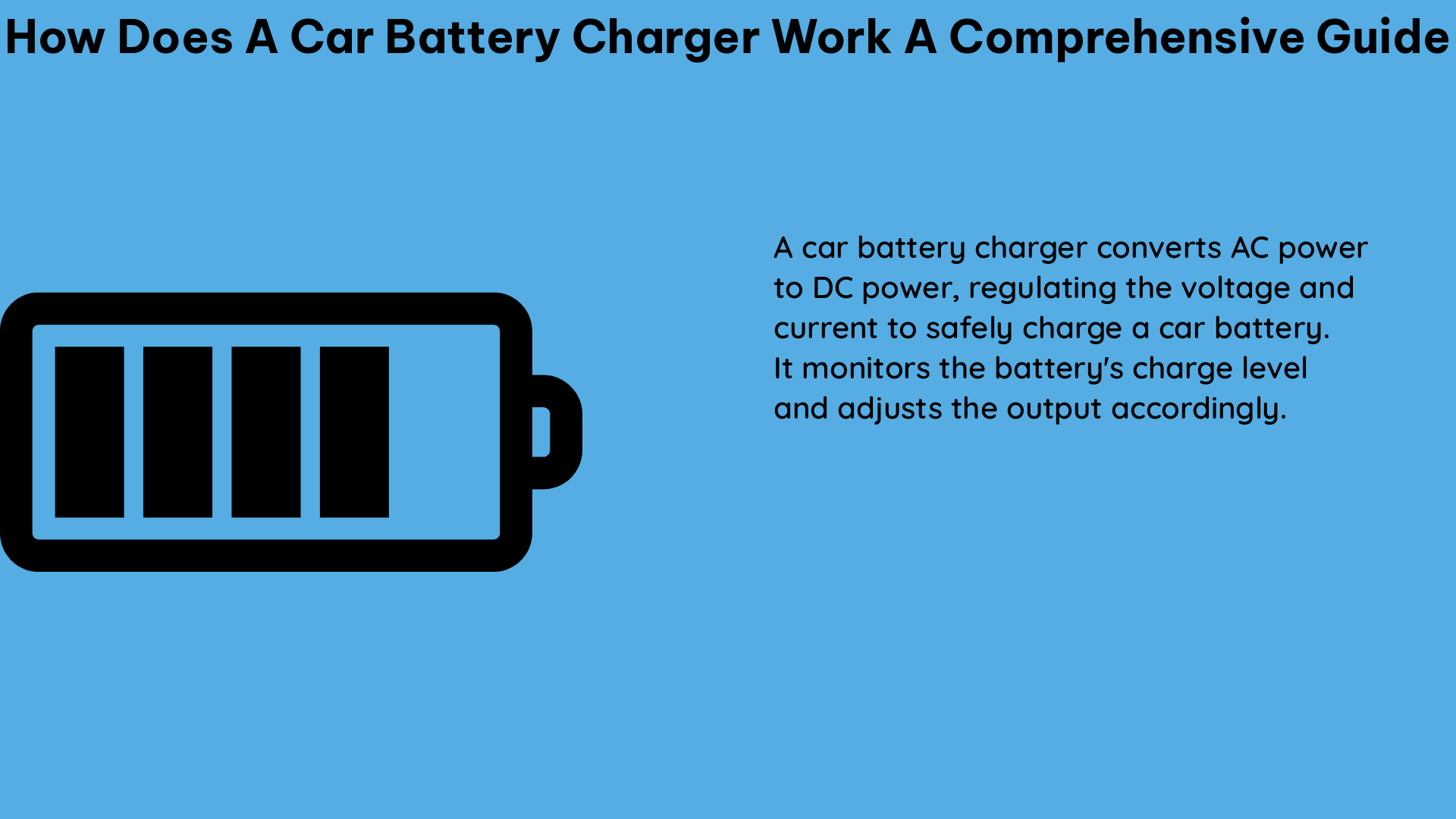A car battery charger is an essential tool for maintaining the health and longevity of your vehicle’s battery. By understanding the intricate workings of a car battery charger, you can ensure your battery remains in optimal condition, providing reliable starting power and extending its service life.
The Charging Process: Stages and Principles
The car battery charging process typically involves three distinct stages: bulk charging, absorption charging, and float charging. Each stage plays a crucial role in restoring and preserving the battery’s charge.
Bulk Charging Stage
During the bulk charging stage, the charger delivers a high current to the battery, rapidly replenishing its charge. This stage continues until the battery reaches approximately 80% of its full charge capacity. The high current ensures a quick and efficient charge, but it must be carefully controlled to prevent overheating and potential damage to the battery.
Key Specifications:
– Charging Current: Typically 10-20% of the battery’s Ah (Ampere-hour) rating
– Charging Voltage: Varies based on battery type, but generally between 14.4V to 14.8V for lead-acid batteries
Absorption Charging Stage
As the battery approaches full charge, the charger transitions to the absorption charging stage. During this stage, the charger reduces the current and maintains a constant voltage to ensure the battery reaches its full charge without overcharging. This stage is critical for preventing damage to the battery due to excessive heat and gas buildup.
Key Specifications:
– Charging Current: Gradually decreases as the battery approaches full charge
– Charging Voltage: Remains constant, typically between 14.4V to 14.8V for lead-acid batteries
Float Charging Stage
The final stage of the charging process is the float charging stage. In this stage, the charger supplies a low current to the battery, compensating for the natural self-discharge that occurs over time. This stage is essential for preserving the battery’s longevity and preventing sulfation, a common cause of battery failure.
Key Specifications:
– Charging Current: Typically 1-3% of the battery’s Ah rating
– Charging Voltage: Slightly lower than the absorption stage, around 13.5V to 13.8V for lead-acid batteries
Battery Chemistry and Charger Compatibility

The type of battery in your vehicle plays a crucial role in selecting the appropriate car battery charger. Different battery chemistries, such as lead-acid, lithium-ion (Li-ion), and nickel-based (NiCd, NiMH), require specific charging parameters to ensure optimal performance and safety.
Lead-Acid Batteries:
– Require a charger capable of delivering a constant voltage between 2.30V per cell (float) and 2.45V per cell (fast charge)
– The charger should switch to float charge when the battery is fully saturated to prevent overcharging
Lithium-Ion (Li-ion) Batteries:
– Require a charger with a constant-current, constant-voltage (CC/CV) charging profile
– Charging voltage should not exceed 4.2V per cell, and the charger should switch to a trickle charge when the battery is full
Nickel-Based Batteries (NiCd, NiMH):
– Require a charger that can provide a constant current during the bulk charging stage
– The charger should switch to a trickle charge or terminate the charge when the battery is full to prevent overcharging
Ensuring the car battery charger is compatible with your vehicle’s battery chemistry is crucial for maintaining its health and preventing potential damage.
Best Practices for Optimal Battery Performance
To maximize the performance and longevity of your car battery, it’s essential to follow these best practices when using a car battery charger:
- Charge the Battery at Low State-of-Charge (SoC): Charge the battery when its SoC is low, as charge acceptance decreases when the battery reaches a SoC of 70% and higher.
- Avoid Overcharging: Do not fill the battery beyond its full state-of-charge, as excess energy turns into heat and gas, potentially causing permanent damage.
- Use the Correct Charger: Ensure the car battery charger is compatible with the intended battery chemistry, and that the battery voltage agrees with the charger’s specifications.
- Charge at Room Temperature: Charge the battery at room temperature, as charge acceptance drops when the battery is cold.
- Monitor Charge Temperature: Ensure lead-acid batteries stay lukewarm to the touch, nickel-based batteries get warm towards the end of charge but must cool down on “ready,” and Li-ion should not rise more than 10ºC (18ºF) above ambient when reaching full charge.
By following these best practices, you can ensure your car battery remains in optimal condition, providing reliable starting power and extending its service life.
Conclusion
A car battery charger is a crucial tool for maintaining the health and longevity of your vehicle’s battery. By understanding the three-stage charging process, the importance of battery chemistry compatibility, and the best practices for optimal performance, you can effectively use a car battery charger to keep your car running smoothly.
Remember, regular maintenance and proper charging techniques are essential for ensuring your car battery remains in top condition, ready to provide the reliable starting power you need, whenever you need it.
References:
– How to Charge a Lead-Acid Battery
– How Do Battery Chargers Work
– How a Car Battery Charger Can Keep Your Vehicle Ready to Go

The lambdageeks.com Core SME Team is a group of experienced subject matter experts from diverse scientific and technical fields including Physics, Chemistry, Technology,Electronics & Electrical Engineering, Automotive, Mechanical Engineering. Our team collaborates to create high-quality, well-researched articles on a wide range of science and technology topics for the lambdageeks.com website.
All Our Senior SME are having more than 7 Years of experience in the respective fields . They are either Working Industry Professionals or assocaited With different Universities. Refer Our Authors Page to get to know About our Core SMEs.